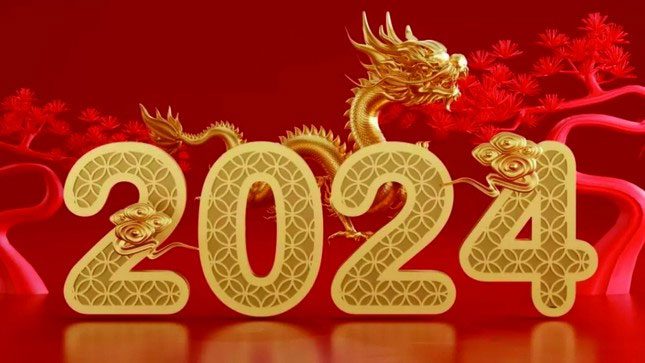Not many people realize that the Year of the Dragon (Giáp Thìn) 2024 has only 354 days and 23 solar terms? Some may wonder, isn’t every year supposed to have 365 days and 24 solar terms? So, where have the 11 days and 1 solar term gone?
Looking at the calendar, we can see: “The year 2024 AD is a leap year, consisting of a total of 366 days and 53 weeks. The Giáp Thìn year in the lunar calendar (Year of the Dragon) does not have a leap month, totaling 354 days and 23 solar terms. Moreover, it is notably marked that the start of the Giáp Thìn year 2024 is from February 10, 2024, to January 28, 2025, when it ends.”
In other words, 2024 is the Year of the Dragon, with the first day of the Lunar New Year (Tết Nguyên Đán) falling on February 10, 2024, according to the Gregorian calendar, and January 28, 2025, marking the New Year’s Eve, totaling 354 days. Observing from the first day of the Giáp Thìn Tết, we can see that the first solar term that appears is “Westerly Rain” on the 10th day of the first lunar month. So, where has the solar term “Beginning of Spring” disappeared?

In fact, the Beginning of Spring in 2024 is on February 4, corresponding to the 25th day of the 12th month in the Year of the Cat.
In fact, the Beginning of Spring in 2024 is on February 4, corresponding to the 25th day of the 12th month in the Year of the Cat. In other words, the Year of the Cat 2023 has two days for the Beginning of Spring, one on the 14th day of the first month and one on the 25th day of the 12th lunar month, leading to the absence of the Beginning of Spring solar term in the Giáp Thìn year.
This situation occurs because scientists compiling ancient calendars add a leap month to the lunar calendar every 19 years to adapt to changes in weather. In 19 years, there will be 7 years without the Beginning of Spring solar term, 7 years with 2 days of Beginning of Spring, and 5 years with one day. This is the result of a necessary “adjustment” between the Gregorian calendar and the lunar calendar.
“Adjustment” between the Gregorian and Lunar Calendars
In ancient times, there were no time-measuring devices as we have today, so people could only make guesses by referencing certain natural phenomena. Some noticed that the sun rises and sets in a very regular pattern, so they used the sun to measure time. Others observed that the phases of the moon also have a regular pattern, so they measured time using the moon. There were also those who calculated time by observing both the sun and the moon.
Through the historical development of timekeeping, those who measured time based on the sun invented what we call “solar calendar”; those who measured time based on the moon invented the “lunar calendar.” Those who considered both the sun and the moon to measure time developed “lunar-solar calendar,” which is the current agricultural calendar.
However, the length of a year in the Gregorian calendar is 365 days in a common year and 366 days in a leap year; the length of each day is about 23 hours and 56 minutes. Subsequently, every four years, there is a leap day added to compensate for this time discrepancy, thus making the length of a year in the Gregorian calendar approximately 365.25 days, which we commonly refer to as 365 days.
The lunar calendar determines days and months based on the phases of the moon. A lunar month has an average of 29.5306 days, while 12 lunar months total 354 or 355 days. Thus, the time difference between the lunar year and the solar year (approximately 365.25 days) is about 11 days, and the cumulative time difference over 3 years exceeds one month. Therefore, a type of calendar had to be invented to make them compatible, which is the “lunar-solar calendar.”
The current lunar calendar is the “lunar-solar calendar”, based on the cyclical changes of the moon’s phases. Each cycle of waxing and waning (“new moon” – “full moon”) is one month. Referring to the length of the solar cycle as one year, and adding 24 solar terms, a leap month is established to align with the solar year. In this way, the calendar can adapt to changes in weather, ensuring that the four seasons are not detached from the solar terms.




















































